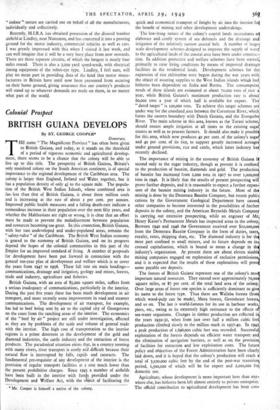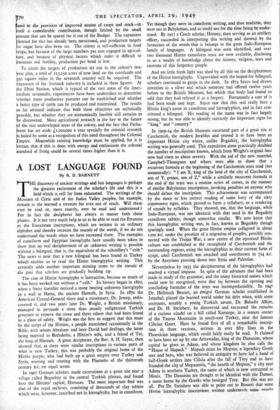Colonial Prospect
BRITISH GUIANA DEVELOPS
By ST. GEORGE COOPER*
T, Demerara. HE name " The Magnificent Province " has often been given to British Guiana, and today, as it stands on the threshold of a period of vigorous economic and agricultural develop- ment, there seems to be a chance that the colony will be able to live up to this title. The prosperity of British Guiana, Britain's only mainland colony on the South American continent, is of special importance to the regional development of the Caribbean area. The colony is larger than England, Ireland and Wales together, but it has a population density of only 44 to the square mile. The popula- tion of the British West Indian Islands, whose combined area is far. less than that of British Guiana, is about three million souls and is increasing at the rate of about 2 per cent. per annum. Improved public health measures and a falling death-rate indicate a tremendous increase in their population over the next fifty years, and whether the Malthusians are right or wrong,'it is clear that an effort must be made to prevent the maladjustment between population and resources becoming too great. In this connection, British Guiana, with her vast undeveloped and under-populated areas, remains the "..safety-valve " of the Caribbean. The British West Indian economy is geared to the economy of British Guiana, and on its progress depend the hopes of the colonial communities in this part of the Empire for an improved standard of living. A number of proposals for development have been put forward in connection with the general ten-year plan of development and welfare which is to cover the years from 5947 to 1956. These fall into six main headings— communications, drainage and irrigation, geology and mines, forests, trade and industry, agriculture and fisheries.
British Guiana, with an area of 85,000 square miles, suffers from a serious inadequacy of communications, particularly in the interior. During the past five years there has been much development in air transport, and more recently some improvement in road and steamer communications. The development of air transport, for example, has led to beef being sent by air to the capital city of Georgetown on the coast from the ranching areas of the interior. The economics of the " beef by air " project are still under investigation, affected as they are by problems of the scale and volume of general trade with the interior. The high cost of transportation to the interior regions is a prime deterrent to the development of the gold and diamond industries, the cattle industry and the extraction of forest products. The paradoxical situation exists that, in a country teeming with many rivers, river transport is costly and difficult because their natural flow is interrupted by falls, rapids and cataracts. The fundamental pre-requisite of any development of the interior is the provision of regular transport facilities at a cost much lower than the present prohibitive charges. Since 1945 a number of airfields have been built in the interior with funds provided under the Development and Welfare Act, with the object of facilitating, the * Mr. Cooper is himielf a native of the colony.
quick and economical transport of freight by air into the interior fix)• the benefit of mining and other development undertakings.
The low-lying nature of the colony's coastal lands necessitates elaborate and costly system of sea defences and the drainage irrigation of the relatively narrow coastal belt. A number of large scale development schemes designed to improve the supply of water) ., to the agricultural lands of the coastal area have been under construc4 tion. Iq addition protective and welfare schemes have been started, primarily to raise living conditions by means of improved drainages facilities in the residential lands. Development schemes for thei expansion of rice clilthiation were begun during the war years withl the object of assuring supplies to the West Indian islands which had hitherto been dependent on India. and Burma. The consumption; needs of these islands are estimated at about 70,000 tons of rice year, while British Guiana's maximum production rate is about 6o,000 tons a year of which half is available for export. They " dated target " is roopoo tons. To achieve this target schemes are, under way for the coastlandiarea between the Corentyne River, which forms the eastern boundary with Dutch Guiana, and the Essequibo River. The main scheme in this area, known as the Torani scheme,' should ensure ample irrigation at all times to the existing sugat° estates as well as to peasant farmers. It should also make it possibl for this area, which now produces 4o per cent. of the colony's suga and 4o per cent. of its rice, to support greatly increased acreages, under ground provisions, rice and cattle, which latter industry has'
recently declined. .
The importance of mining in the economy of British Guiana NI second only to the sugar industry, though at present it is confined to the production of bauxite, diamonds and gold. The production of of bauxite has increased from 2,000 tons in 1917 to over i,000 tons in 1946. It is likely that the results of present prospecting w prove further deposits, and it is reasonable to expect a further expan sion of the bauxite mining industry in the future. Most of the mining is done by the Demerara Bauxite Company, but recent publH cations by the Government Geological Department have caused other companies to become interested in the possibilities of further' deposits in the colony, and the American Reynolds Metals Company is carrying out extensive prospecting, while an engineer of Mr'
oc j Henry Kaiser's Permanente Metals has inspected areas in the colony Between 5940 and 1946 the Government received over Sio,000, , from the Demerara Bauxite Company in the form of duties, taxes royalty, rents, shipping dues, etc. The diamond industry is for thq most part confined to small miners, and its future depends on in creased capitalisation, which is bound to mean a change in dna industry's organisation. At. present there are about eleven sizabl mining companies engaged on exploration of exclusive permissions and it is expected that the results of these explorations will provej some payable ore deposits.
The forests of British Guiana represent one of the colony's mos important natural resources. They extend over approximately 7o, square miles, or 87 per cent. of the total land area of the colony. Over large areas of forest one species is sufficiently dominant to giv its name to the forest type. Thus there are Wallaba forests (f which wood-pulp can be made), Mora forests, Greenheart forests and so on. The last is world-famous for its use in harbour works, piers, etc., owing to its extremely high resistance to the effects sea-water organisms. Changes in timber production are reflected i the years 1930-31, when from just over half a million cubic fee pioduction climbed slowly to the million mark in 1937-40. In 1942 a peak production of 1,696,00o cubic feet was recorded. Successf exploitation of the forests depends on efficient water transport' the elimination of navigation barriers, as well as on the provisio of facilities for extraction and low exploitation costs. The futur policy and objectives of the Forest Administration have been clearly laid down, and it is hoped that the colony's production will reach a total of 3,5oo,000 cubic feet by the end of the post-war transitioni period, 1,50o,000 of which will be for export and 2,000,000 foti domestic use.
Agriculture, whose development is more in here than any.; where else, has hitherto been left almost entirely to private enterprise. The official contribution to agricultural development has been con.
7e0 THE SPECTATOR,
d to the provision. of improved strains of crops and stock—in - tself a .considerable contribution, though limited by the small ount that can be spared for it out of the Budget. The expansion fanned for rice has already been mentioned,. and production targets for sugar have also been set. The colony is self-sufficient in food rops, but because of the large numbers per acre engaged in agricul- ture, and because of physical factors which make it difficult to lmaintain soil fertility, production per head is low.
To attain the targets of production set out in the colony's ten- /year plan, a total of 113,15o acres of new land on the coastlands and 65o square miles in the savannah country will be required. The expansion of the livestock industry is included in these figures. At the Ebini Station, which is typical of the vast areas of the inter- niediate savannahs, experiments have been undertaken to determine whether more productive pastures can be established and whether a better type of cattle can be produced and maintained. The results so far attained indicate that both these objectives are technically possible, but whether they are economically feasible still remains to be discovered. More agricultural research is the key to the future bf the vast undeveloped areas of the colony, and the fact that Parlia- nent has set aside kr,000,000 a year specially for colonial research is hailed by some as a recognition of this need throughout the Colonial Empire. Meanwhile existing knowledge must be applied, for it is 'certain that if this is done with energy and enthusiasm the colonial Standard of living could be several times higher than it is.



































 Previous page
Previous page